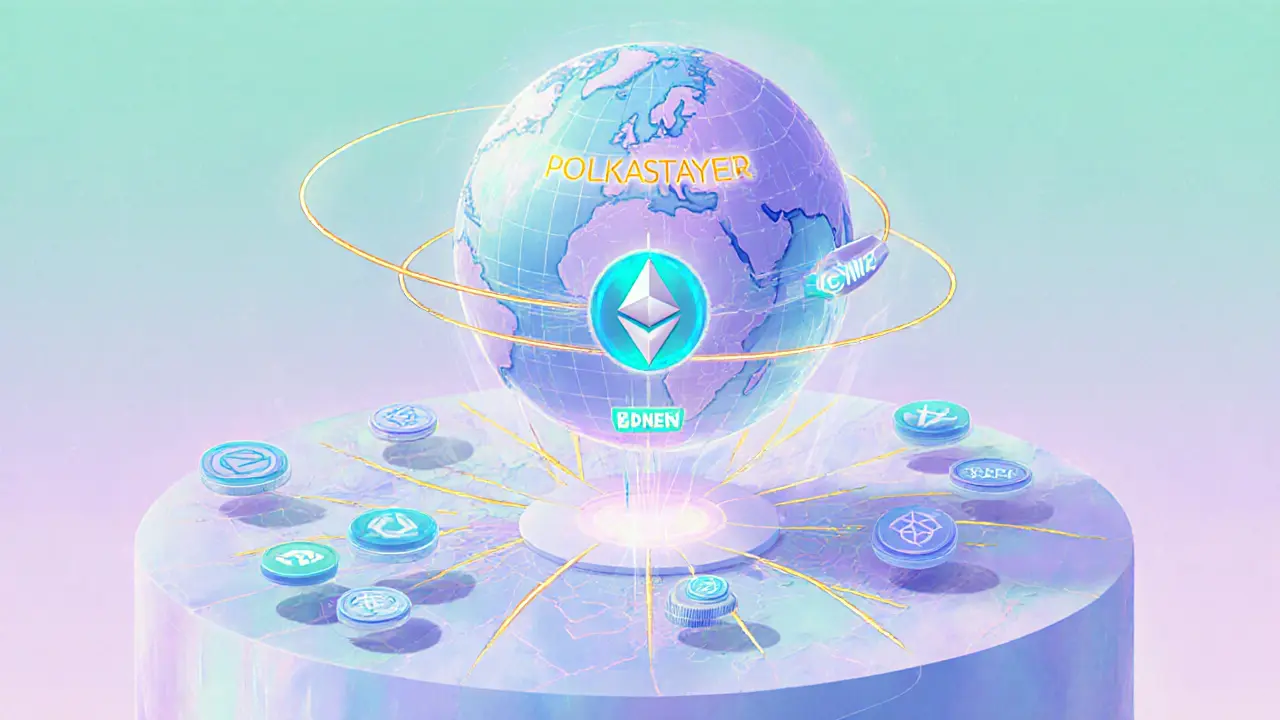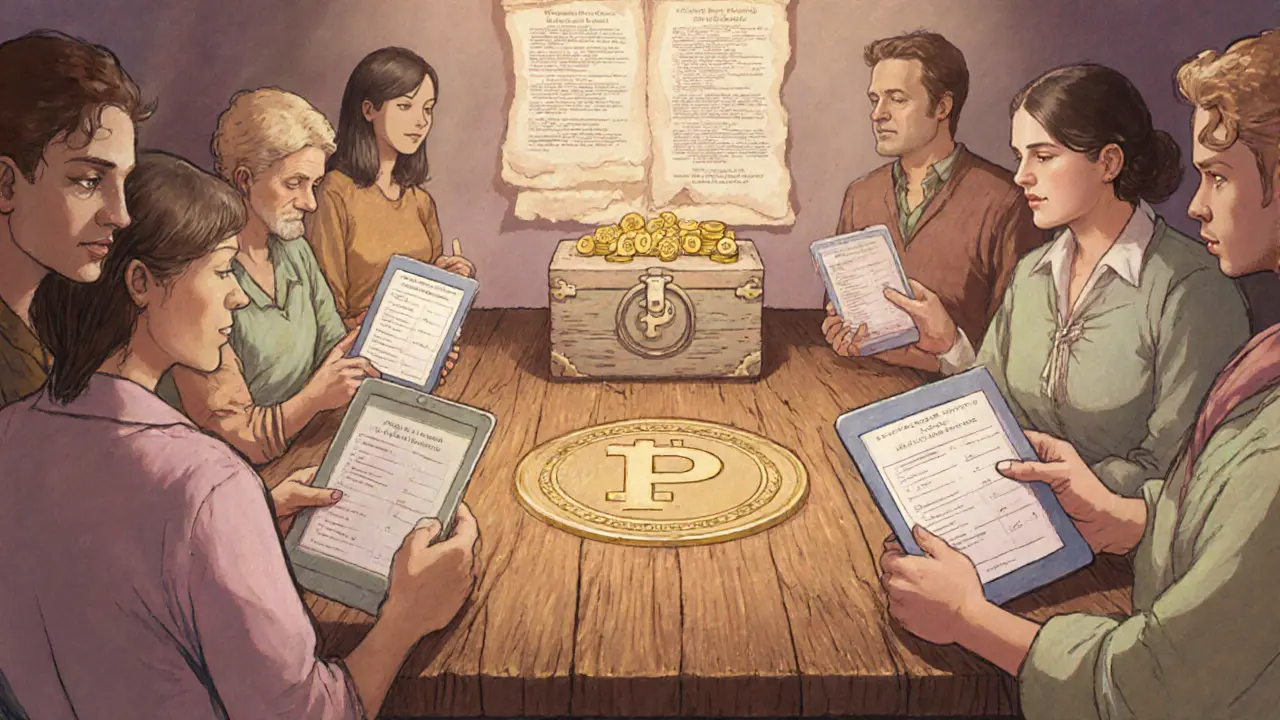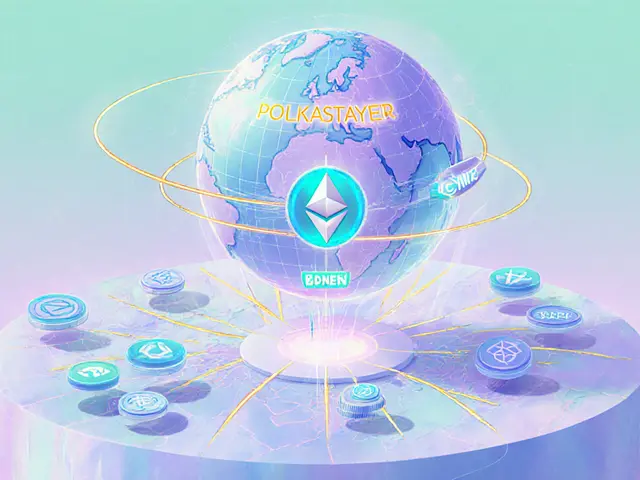Polkastarter (POLS) Explained: The Cross‑Chain Crypto Launchpad Token

POLS Token Value Calculator
Investment Summary
Initial Investment:
$0.00
Potential Return:
$0.00
Total Value After Staking:
$0.00
ROI Percentage:
0.00%
Note: This calculator estimates potential returns based on fixed inputs. Actual returns may vary due to market fluctuations and changes in staking rewards.
When you hear the term Polkastarter, you’re looking at a platform that lets new blockchain projects raise money without a central gatekeeper and gives investors a chance to get in early on promising tokens.
Key Takeaways
- Polkastarter is a decentralized launchpad built on Polkadot that supports multiple blockchains.
- The native POLS token provides governance, fee payment, and priority access to IDOs.
- Fixed‑swap smart contracts lock in token prices, reducing the volatility seen on AMM‑based launchpads.
- As of October2025 the token trades around $1.00 with a market cap of roughly $16million.
- Investors can stake POLS, vote on project listings, and participate in cross‑chain token sales across seven major networks.
What is Polkastarter?
Polkastarter is a permissionless, cross‑chain launchpad that enables blockchain projects to raise funds through Initial DEX Offerings (IDOs). Launched in December2020, the protocol started on Ethereum before expanding to Polkadot’s ecosystem, where it now runs on a network of bridges linking Ethereum, BNB Chain, Polygon, Avalanche, Solana, Celo and Polkadot itself.
How the POLS Token Powers the Platform
The POLS token is the glue that holds the Polkastarter ecosystem together. Its three core roles are:
- Governance: Holders vote on which projects get featured, shaping the launch calendar.
- Access: Staked POLS grants priority whitelist spots for upcoming IDOs, NFTs and gaming Web3 drops.
- Fees: Transaction fees on the platform are paid in POLS, creating ongoing demand.
Staking also rewards loyal participants with “Power Boosters,” which raise the chance of a successful whitelist allocation.
Technical Architecture and Cross‑Chain Features
At its core, Polkastarter uses fixed‑swap smart contracts. Unlike automated market makers (AMMs), these contracts set a fixed price for a token sale and execute all swaps automatically when the pool fills. This eliminates price‑slippage risk during a launch.
Polkadot’s relay chain provides the scalability and low‑cost environment that makes cross‑chain swaps practical. Bridges connect Polkadot to other ecosystems, allowing a project to raise funds in DOT, ETH, BNB or other supported assets while still issuing a native token on its home chain.

Market Performance and Financial Snapshot (Oct2025)
- Rank: #982 on CoinMarketCap
- Market Cap: $16,757,637 USD
- Current Price: ≈ $1.00 (up 0.47% over 24h)
- All‑time high: $1.78 (July2022)
- Circulating Supply: ~16.5million POLS
- Number of successful IDOs: >100 projects launched
Growth has been driven by Polkadot’s rising ecosystem, strategic institutional backing, and the platform’s reputation for delivering predictable, low‑fee token sales.
How to Participate in an IDO with POLS
If you want a slice of the next hot token, follow these steps:
- Acquire POLS on a supported exchange (e.g., Binance, KuCoin, or a DEX on Polygon).
- Stake the required amount of POLS on the Polkastarter dashboard - the amount varies per IDO.
- Complete KYC if the upcoming sale demands it (some IDOs are fully permissionless).
- Watch the whitelist announcement; staked POLS gives you a higher ranking.
- When the sale opens, confirm your contribution in the supported currency (ETH, BNB, DOT, etc.).
- After the pool fills, receive the new token directly in your wallet.
Remember: the fixed‑swap model means you’ll get the token at the advertised price, regardless of market swings during the sale.
Polkastarter vs. Other Launchpads
| Feature | Polkastarter | Binance Launchpad | Solanium |
|---|---|---|---|
| Supported Chains | Ethereum, BNB Chain, Polygon, Avalanche, Solana, Celo, Polkadot | Binance Smart Chain (BSC) only | Solana only |
| Sale Mechanism | Fixed‑swap smart contracts | Lottery & allocation via BNB holdings | Fixed‑swap with token‑gate |
| Governance | POLS‑holder voting on project listings | Centralized curation by Binance team | Community voting but limited scope |
| Fee Token | POLS | BNB | SLIM |
| Typical Fees | Low (≈0.5% of pool) | Higher (≈1-2% + gas) | Low to moderate |
Polkastarter’s multi‑chain flexibility and community‑driven governance give it an edge for projects that want to avoid single‑chain lock‑ins.
Risks and Considerations
- Smart‑contract risk: Although audited, bugs could affect token swaps.
- Market volatility: POLS price can swing, impacting staking rewards.
- Regulatory uncertainty: IDOs may attract scrutiny in some jurisdictions.
- Project quality: Not every listed project succeeds; due diligence remains essential.
Mitigate these risks by diversifying across several IDOs, using hardware wallets for POLS, and staying updated on regulatory news.
Future Outlook and Roadmap
Polkastarter aims to broaden its bridge network, potentially adding support for Cosmos and Near in 2026. Upcoming governance upgrades will let POLS holders propose custom fee structures, and the team plans to introduce a “Liquidity Mining” program that rewards participants who provide liquidity to launched tokens.
With over 100 successful token sales and a growing institutional backer in Digital Finance Group, the platform is well‑positioned to remain a go‑to launchpad as the crypto world shifts toward true interoperability.

Frequently Asked Questions
What is the primary purpose of Polkastarter?
Polkastarter provides a decentralized platform where new blockchain projects can raise funds via IDOs, while giving investors early access to these tokens across multiple blockchains.
Do I need POLS to join an IDO?
Yes. Staking POLS is the main way to gain whitelist priority for most launches, though the exact amount required varies per project.
How can I buy POLS?
POLS is listed on major centralized exchanges like Binance and KuCoin, as well as decentralized exchanges on Ethereum, Polygon and BNB Chain. Simply place a market or limit order on your chosen platform.
What is a fixed‑swap smart contract?
It’s a contract that locks the token price for the duration of a sale. All purchases are executed at that price once the pool is filled, eliminating price‑slippage.
Is Polkastarter safe for my funds?
The platform undergoes regular security audits, but no system is 100% risk‑free. Always use a reputable wallet, enable two‑factor authentication on exchanges, and only invest amounts you can afford to lose.






🔥 TL;DR: POLS looks shiny but the TVL on Polkastarter is still meager, APY bragging rights are hype‑driven, and the cross‑chain bridge could be a vector for rug pulls. 🚀 The tokenomics claim 5% weekly emissions, but that dilutes holders faster than a DeFi flash loan. 📉 If you’re chasing yield, consider the opportunity cost vs. staking on more established platforms like Ethereum L2s. Also, the governance DAO is still a ghost town-no real proposals have passed. In short, treat POLS like a speculative meme rather than a blue‑chip launchpad. ⛔️
Polkastarter is just another overhyped launchpad that will never live up to its promises.
I think it’s worth noting that Polkastarter does bring real utility by enabling cross‑chain token sales, which can lower barriers for new projects. The staking rewards are competitive, but remember they’re paid in POLS, so the token’s price volatility directly affects your ROI. Also, the community governance has been slowly gaining traction, with a few proposals already on the table. If you diversify and only allocate a small portion of your portfolio, it could be a decent experiment.
Look, the market is saturated with launchpads that promise moon but deliver dust. POLS suffers from the same liquidity crunch syndrome and the inter‑chain protocols are still in beta, meaning you’re basically betting on speculative arbitrage. The reward curve looks seductive, yet the underlying smart contract risk is non‑trivial. In short, proceed with caution.
When we examine the epistemology of hype, we discover that the very act of labeling a project “overhyped” is a self‑fulfilling prophecy, for the narrative shapes market behavior. Thus, the assertion that Polkastarter “will never live up” may be less a factual forecast and more an expression of collective doubt, which itself can impede adoption. In this light, the proposition demands a more nuanced dialectic rather than a categorical dismissal.
Alright folks, let’s break this down step by step because the POLS ecosystem is a tapestry of interwoven incentives that many newcomers miss. First, the token distribution allocates 40% to the community, 25% to the team, and the remaining 35% to liquidity mining and strategic partners, which means there’s a continual inflow of new tokens that could dilute early investors if the release schedule isn’t carefully managed. Second, the staking mechanism offers an annual reward rate that hovers around 20%, but that figure is predicated on a stable price-any volatility will swing your effective yield dramatically. Third, cross‑chain capabilities are indeed a differentiator; projects can launch on Binance Smart Chain, Polygon, and even Solana through the Polkastarter interface, opening up a broader user base. Fourth, the governance DAO, while still nascent, has recently passed three proposals regarding fee adjustments, indicating a slowly maturing decision‑making process. Fifth, the partnership network includes several reputable DeFi protocols, which could provide liquidity buffers during market downturns. Sixth, the user experience on the UI is fairly intuitive, though the occasional gas spikes during high‑traffic events can be a pain point. Seventh, security audits have been conducted by leading firms, yet no system is impervious-always consider a multi‑layered risk assessment. Eighth, community sentiment on Discord shows a mix of optimism and caution, reflecting the broader market mood. Ninth, the token’s market cap remains below $200 M, placing it in the mid‑cap category, which historically carries higher upside potential but also greater risk. Tenth, you should keep an eye on the upcoming token burn events, as they are designed to counteract inflation. Eleventh, the staking rewards are paid in POLS, so you’re essentially reinvesting into the same asset you’re staking-a compounding effect if the price rises, but a negative feedback loop if it falls. Twelfth, the liquidity pools on major DEXes have been expanding, suggesting growing confidence among traders. Thirteenth, regulatory considerations are still vague; cross‑chain bridges can attract scrutiny, so stay updated on legal developments. Fourteenth, the roadmap includes a launchpad “v2” with enhanced KYC modules, which could attract institutional participants. Finally, the bottom line: if you allocate a modest percentage of your portfolio, stay vigilant, and diversify, POLS can be a strategic play in the broader crypto launchpad arena.
looks like another launchpad but i guess it could work for some small projects
Wow, stepping into the Polkastarter world feels like opening a kaleidoscope of possibilities-each token sale is a burst of color, and POLS is the prism that refracts opportunity across chains. The vibe is fresh, the community buzzing, and the staking rewards sprinkle a little extra sparkle on the horizon.
Building on what Richard mentioned, it’s essential to appreciate that cross‑chain facilitation isn’t just a convenience but a strategic lever that can accelerate project lifecycles. When a token sale can tap into both Binance Smart Chain and Polygon, the liquidity inflow can be exponentially larger, which in turn fuels price discovery and market depth. Moreover, the governance momentum is gradually shifting from a passive observer model to an active participatory framework, meaning that token holders will eventually wield meaningful influence over fee structures and future feature rollouts. If you layer that with the fact that staking rewards are tied to POLS’s own market performance, you essentially have a feedback mechanism that aligns incentives: as the ecosystem thrives, so does the reward yield. That said, a diversified approach-allocating perhaps 2‑5% of your crypto exposure to POLS while maintaining core holdings in more established assets-could provide a balanced risk‑return profile.
It is incumbent upon the discerning investor to recognize that the Polkastarter initiative, while embellished with contemporary vernacular, ostensibly suffers from an insufficiency of substantive differentiators relative to its contemporaries. The purported cross‑chain functionalities, albeit laudable in theory, have yet to demonstrate a quantifiable superiority in terms of throughput or security. Consequently, a prudent allocation strategy would entail a circumscribed exposure, subordinate to assets of incontrovertible pedigree.
Yo, if you’re looking for a fresh spot to throw some crypto, Polkastarter’s got that hype energy-stake, earn, and maybe catch the next big project launch. Just don’t go all‑in, keep it chill.
Exactly, Chad. To add, keep an eye on the reward APY curves-they adjust based on total staked volume, so timing your entry can make a noticeable difference in returns. Also, consider pairing your POLS stake with a small portion of stablecoins in the liquidity pool to hedge against volatility while still earning fees.
Friends, while the arena may seem crowded, Polkastarter offers a genuine avenue for emerging projects to find their footing. Approach it with measured optimism and remember that consistent, modest contributions often yield the most sustainable growth.
Honestly, another launchpad? 🤷♂️
From a macro‑economic perspective, the introduction of POLS into a diversified portfolio must be evaluated against its beta coefficient relative to the broader crypto index. Historical data indicates a higher variance, which translates to increased risk. Therefore, any investment should be proportionally limited to maintain the desired Sharpe ratio.
Polkastarter is nothing but a glorified pump‑and‑dump scheme.
Stay positive! The cross‑chain vision of Polkastarter could unlock untapped markets, and early adopters stand to benefit as the ecosystem matures.